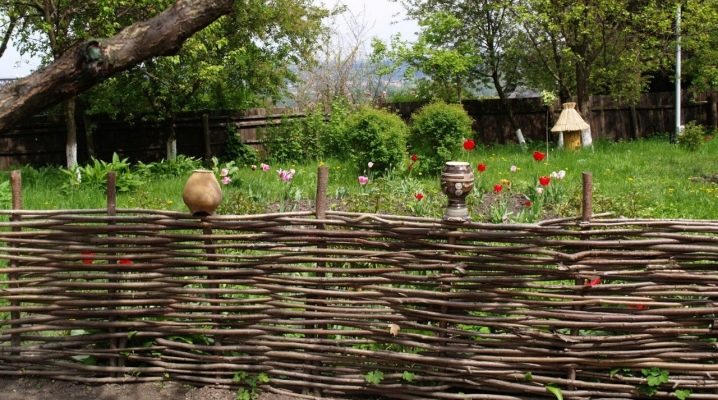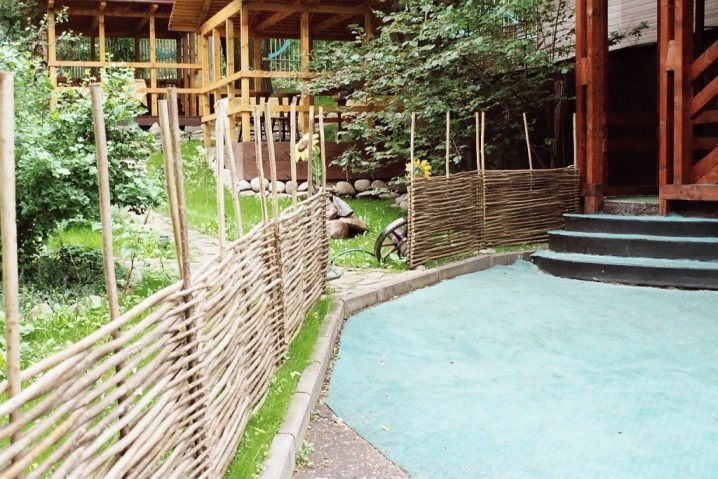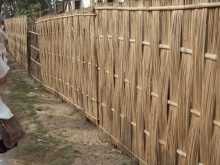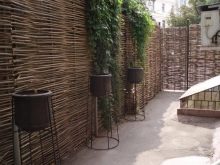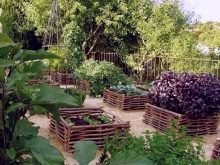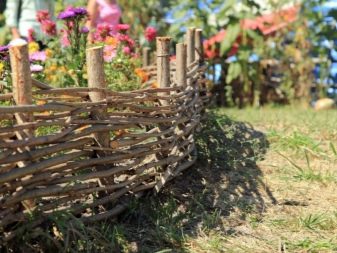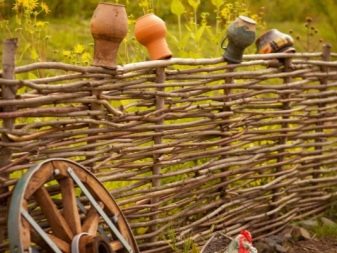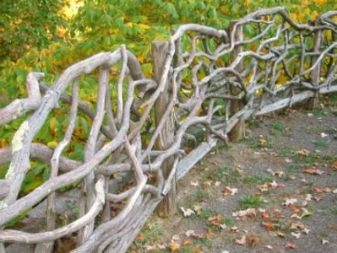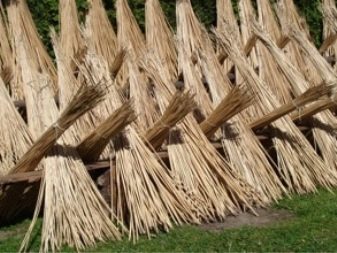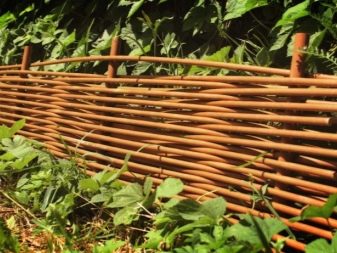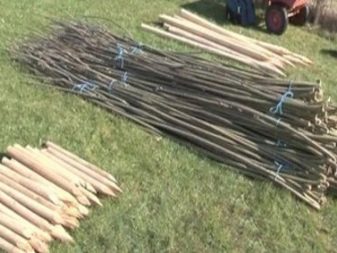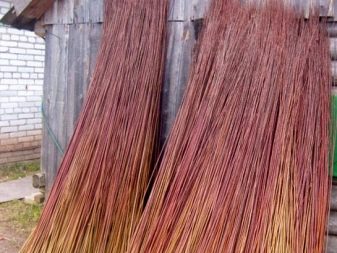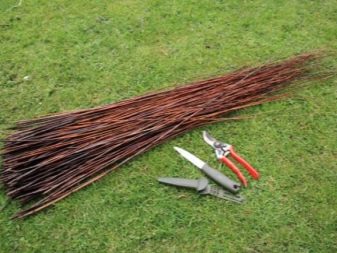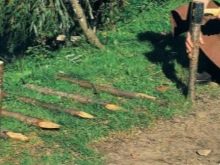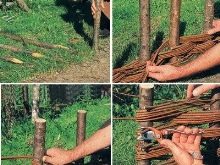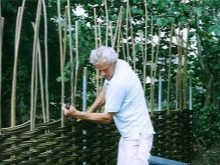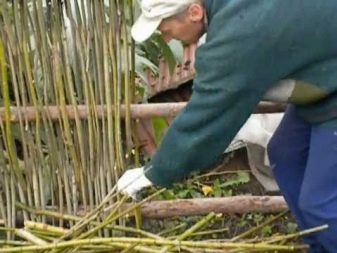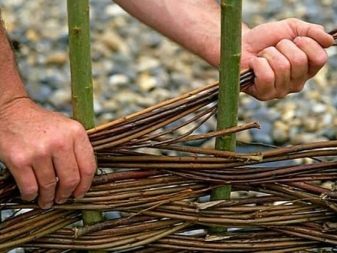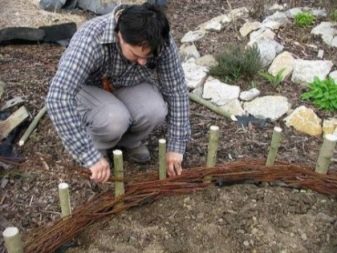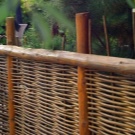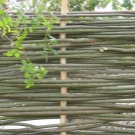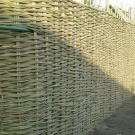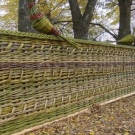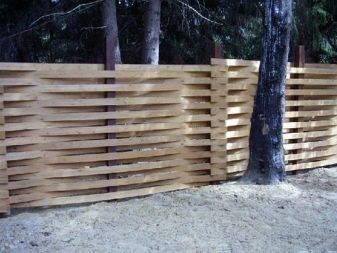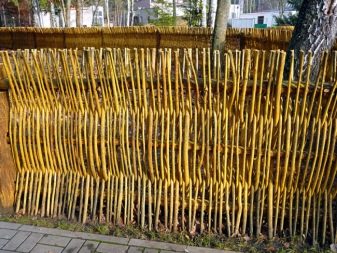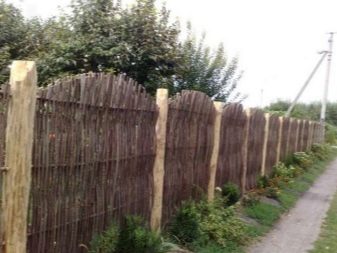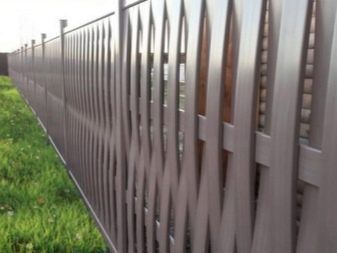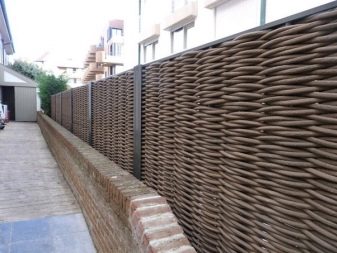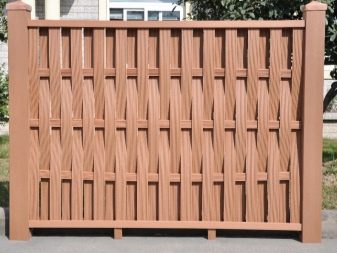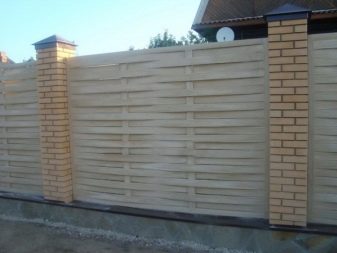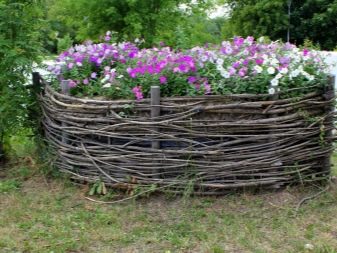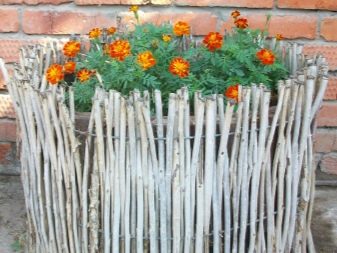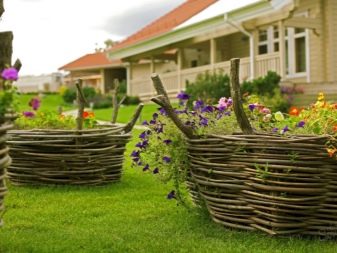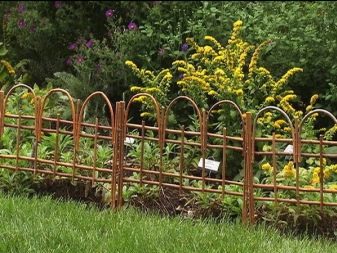The details of the wicker fence
There is a great variety of types of fences that can protect a land plot and a house from outside invasion. However, such a primitive and outdated version, considered by many people as a wicker fence, is capable of protecting a little worse than more solid structures. In this case, anyone can create it, and the appearance will please even those who do not make aesthetic compromises.
Special features
Even 80-100 years ago, to meet the wicker fence could have been incomparably more often than now. The basic material for it is available and relatively inexpensive, the protective structure is light. These advantages persist even today, and it is easy to turn into dignity from the lack of an archaic look, thus beating the surroundings of a country house.Moreover, such a design is easily formed by your own hands, you do not have to look for professionals and wait for them to fulfill the order.
Classical braided is a lightweight barrier of chaotic structure. There is no need to process the material, it is even contraindicated in technology. The overwhelming majority of such fences do not exceed 150 cm in height, since the fragility of raw materials does not allow them to be made very high. We will have to put up with the presence of cracks, and with the inability to create a truly blank wall.
It is recommended to close the areas with relatively small squares with watches or to set them as auxiliary fences in the cottage or vegetable garden.
An alternative application is the delimitation of adjacent areas, attractive minimal formation of shadows. As a result, your interests and the interests of your neighbors will not suffer at all.
High-quality preparation for work is of great importance, only it allows you to finish the job quickly and at the lowest cost. This is not just a fence made of a picket fence, but technical knowledge and the ability to use the tool cannot be avoided.
Material
For many centuries wicker hedges have been made from willow (willow), willow vine and hazel wood. Three plants, with all the differences between them, have oblong branches with a smooth surface, which are easily bent. Some masters use wild reed (cattail), which is more fragile than the branches of trees and shrubs. Bamboo wattles are stronger than ordinary ones, only raw materials will need to be bought, and it will not be possible to prepare it for obvious reasons.
If willow is chosen, there is no need to calculate its consumption, it is recommended to take as much as you see fit. Most often an armful of branches allows you to form a canvas of 50 cm in length and the same in height. More precisely, it is impossible to say without knowing what the diameter of the vine is and how much thick weaving you want to make. Theoretically, you can take young shoots of any tree and even shrubs no shorter than 100 cm. But for beginners it is better to stay on proven options, they give a more stable and predictable result.
It is necessary to harvest willow either in the spring, until the snow melted, or in autumn, when the snow cover was only established. The reason is simple: the speed of movement of juices is limited, the leaves are the least.
Try to choose shoots as even and longer as possible; if you do not proceed to construction immediately, take care of drying the collected branches.
Instead of natural wood, you can make a fence of PVC, and its decorative properties will be no worse. Such a decision will allow the fence to maintain its functional characteristics and appearance for decades. If you suddenly need to move the fence (when moving, building, new land survey) - this will not be particularly difficult.
Polyvinyl chloride does not fade even in the bright sun, he is not afraid of fierce cold and extreme heat. All care comes down to rubbing with a special tool and restoring the anti-corrosion coating on metal parts.
The wattle made of PVC is much more varied in possible colors than wooden structures, and by varying the pitch and size of the cell, you can make it truly extraordinary. If you still firmly choose natural materials, you must also consider the option of using hazel. It is recommended to cut the twigs in early spring and apply as soon as possible, until the thickening juice makes the material hard.Unlike willow, for the same reason, avoid harvesting in the fall and winter. It is possible to increase the rigidity of the fence, if knit it from compounds of 2, 3 or 4 rods.
Hazel will look nicer if you raise the vertical supports, adding to them decorations - flower baskets, painted clay dishes.
How to do?
Operating procedure:
- Having prepared raw materials for the future fence, they begin to make support columns. Their role is often performed by the largest branches, whose diameter exceeds 40 mm. If you use bars, boards, especially metal, the fence will last longer. But you need to do this only if it doesn't matter to you how natural the fence will look.
- Any step by step instruction is based on the fact that the distance separating the supporting elements is 300-500 mm. Increasing it, you save material and accelerate the process, and reducing it - create a more dense and reliable fence. Vertical joining requires the use of longitudinal ties, even in a very low barrier there can be no less than five.
- Weaving from the twigs of willow begins only after the shoots are soaked in water for at least 7 days, if they are completely fresh, you can reduce the period of 1-2 days.After the branches have enough flexibility, the bark is removed from them using a specially prepared branch with stops.
If you do not have such a device, apply pliers or nippers. If the bark is removed with difficulty, it means that the raw material is not ready yet!
- After cleaning the rods, treat them with an antiseptic; If you want to change the color, use the stain. But keep in mind that all branches are processed separately, and therefore for large barriers such processing will be too time consuming, long. By the time you start work, prepare and put a tape measure, garden shears, metal saw, wooden hammer, sledge hammer closer. You will also need a wire (for tightening the rod), a fishing line or construction threads and a screwdriver.
- The universal method of weaving is horizontal, it allows you to give the fence unattainable for the vertical method of density and strength. The line (thread) is drawn, thus denoting a straight line of the fence. This will be a guide when setting footings (the gap between them is 1 m). Each support should be driven in at least 50 cm. If you nevertheless chose a horizontal connection method, you should tie the tops of the supporting elements with slats, preventing deflection to the side.
- Weave the rods into the gap between adjacent pillars and start with a thick edge, forming the number "8". The original pillar is encircled from the front, the next one from the rear, the third again from the front side and they do so until the vine is enough. To prevent the fence from crawling to the ground, the lowest level of the rods is attached with wire to the stakes.
Weaving after the end of each rod begin with the pillar preceding that at which it ended. This is very important, because otherwise the homogeneity of the structure is not achieved.
- When it is the turn to wind the final row of the vines, the fixing bar is removed, and the rods themselves are tied with wire. An important point: putting stakes not directly into the ground, but into plastic pipes, you will significantly increase the period of operation of the fence. It is possible to make a wicker fence from unedged boards, as long as it has sufficient flexibility. Such a design will look more expensive than it actually costs, and in a light day even alone it is easy to form up to 15 m of a fence.
- Before starting work, determine the purpose for which the fence will be used. So, wattles up to 100 cm are needed to decorate the site, their protective function is small.In many cases, such fences surround the flower beds and separate zones in summer cottages, in gardens. Installing the fence in sections means that left and right boundaries appear, coinciding with the gap between the branches. The continuous installation consists in the fact that the next strip is wrapped behind each bar, and a strip having no end is created.
If there are ugly looking places when working, just turn them inward so that you cannot see the outside.
Types of weaving
Wooden wattle can look very diverse and attractive, primarily because it uses complex patterns:
Chess Spin involves the distribution of the vine bundles that are woven horizontally. If you pin down thick (over 50 mm) branches on the top pole, unfold the rods diagonally and attach the other end to the bottom, you will get a diagonal version of a chess twist. In the intervals of her other woven beams should be woven.
If you take branches no thicker than 10 mm, they will also be useful, but for openwork weaving. In order not to look for such material everywhere for a long time, purchase it in any cattery.
But if the openwork weaving is rather an ornament, a separate element, then alpine pletenka deservedly considered a full-fledged type of fences. It is able to encircle the whole territory as well as become a barrier around climbers. The quality of the tree is very high and the product, if done correctly, will work for dozens of years for the glory. Even the most attentive and critical environmentalists will not find anything wrong with this decision.
Supports should be concreted as carefully as possible, since the windage of the main structural elements is great.
The boards need to be processed in advance: they are polished and carefully covered with a preparation that stops the development of microscopic fungi, reducing the negative effect of the sun, rain, hail and snow. A pair of plates is placed on each span, which are placed inside and outside, respectively. For information: when interlacing horizontal planks with vertical ones, make sure that they all bend on each side! You can simplify the work, if you immediately prepare small grooves in the pillars.
The initial fastening is done with nails or glue; subsequent dosochki do not require additional retention, if the technology is fully complied with.To reduce the risk and increase the service life, the wattle is coated with varnishes, varnishes and enamels. Austrian weaving can have a variety of patterns, which are selected for the used wood species, while taking into account the budget of work.
Classic vertical way weaving is not worse than the Austrian method. Given the difference in the size of the vine in the upper part of the shoot and at the roots, it is broken up into pairs, alternately directing the thickest section up and down. This technique avoids differences in the density of the fence at different heights. If instead of branches you use boards, it is recommended to cover their upper parts with another board, giving the composition completeness and making it as resistant as possible to bad weather.
Sometimes the strips are fixed from the bottom, but in this case they cannot be nailed on top, otherwise the wetted tree will be deformed. Applying undressed board, remember: when it dries out completely, 10 mm intervals are formed. It is allowed to use a profile metal pipe as vertical bars, which is safer and more stable.
If not wood but plastic elements (picket fence) are used for the fence, it can be considered that the area is relatively protected not only from intruders, but also from gusts of wind, from atmospheric vortices.
Exact recommendations on how to weave (connect) plastic blocks will be given only by the manufacturer’s instructions or by an experienced specialist. But in any case, you will need to control how smoothly the installation is; fixing the brackets on the poles, it will be possible to put the panels, which will be held by screws or bolts.
Decor
The simplest visual effect is achieved by dyeing the vines: branches liberated from the bark are impregnated with stain. You can make the fence white if it is treated with hydrogen peroxide and kept for 48 hours in a bright place. They give a brown color to the vine by digestion, and to make this color brighter, add some potassium permanganate to the boiling water. If there is a desire to achieve other colors, conventional textile dyes will do. Both horizontal and vertical watts after such processing will seem much more attractive than they were at first.
Combining a wicker fence and plants in flower beds, you can achieve an impressive result: an original border is built around the blooming greenery. There is nothing to think about protection, but the decorative function is realized as completely as possible. There are ready-to-use flower gardens (with a diameter of 0.9 m) that are reinforced in the soil, but weaving can be used as a decoration throughout the territory.
Sunflowers are organically combined with the curtains themselves (at a close upset). If we talk about decorative objects, it is recommended to use everything that reminds of rural life: a cartwheel wheel and stakes, wooden furniture and a rock garden. Imitation of birds sitting on the fence, always looks attractive in any environment. The combination with a stone is considered attractive - alpine hills, rock gardens and paved paths will be very appropriate.
As for flowers, it is recommended to usually put them along the watchers in pots and flowerpots or plant them side by side, but not to combine these two possible solutions. In addition to sunflowers, all climbing crops are considered compatible.
